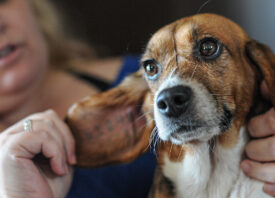Search this site
Bullfighting Is Still Happening. These Photos Show Why It Shouldn’t Be.


“When a matador has really pleased the audience, and they continue to cheer for him, he will cut off one of the dead or dying bull’s ears, holding it aloft while receiving their praise,” the photojournalist Jo-Anne McArthur, who has photographed bullfighting in Spain and beyond, tells me. “If the audience continues to cheer, he’ll cut off the other ear, often throwing them into the audience.
“Often, the bulls are not yet dead but dying from their many wounds. First, they are gouged with blades by the picador, then the jagged banderillas are stabbed into their backs. They bleed profusely, weakening throughout the bullfight, until they are killed with a long sword between their shoulder blades, down into their heart (if it is done correctly). Sometimes, after all this, even after the earless bulls are dragged by horse and cart to the butcher, they are still alive.”

Bullfights, or corridas in Spain, have been banned in some cities and regions, including Catalonia, but bullfighting is still practiced today in some jurisdictions. In 2020, amid the COVID-19 pandemic and related closures, the industry sought help from the Spanish government, although more than 185 thousand people signed a petition against the bailout. Hundreds of bulls were sent directly from ranches to slaughterhouses before bullfighting returned to Spain. In a nation hard-hit by COVID, the bullrings were reopened before the nightclubs and bars.


McArthur is the founder of We Animals Media (WAM), a collective of photo and videojournalists bringing to light the conditions of animals used for entertainment, food, research, and more. She’s also the author of a book by the same name, We Animals, where you can discover some of the images and stories featured here, including those captured at bullfights, as well as behind the scenes at the ranches where the bulls are raised and the slaughterhouses situated behind the arenas.

While covering bullfighting in San Sebastian de los Reyes, she observed matadors attempting the estocada, or running of the animal through the heart. She saw a bewildered bull return again and again to the entrance of the arena, disoriented and longing to escape. She witnessed mortally injured bulls lying on the ground, blood flowing from their mouths and noses, taking their last heaving breaths.

Many of the industries McArthur has photographed over the decades, factory farms to fur farms, operate in darkness and behind closed doors. Although she sometimes found the doors to the slaughterhouse behind the arena closed, much of what she witnessed while documenting bullfighting happened out in the open. As the hot sun beat down on the exhausted bulls, people cheered. In the crowd, she met women waving fans and men smoking cigars. She saw those children catching the bull’s ears, still bloody.

While covering the industry, McArthur also gained entry into a school for bullfighting, located just hours out of Madrid. She spent two hours observing aspiring matadors as they trained. Some were teenagers; others were as young as four. She met one boy, around six, and asked him through a translator why he wanted to become a matador. He told her simply, “Because I love bulls.” For her, that moment represents so much about our fractured relationship with animals: the cognitive dissonance, the lies we tell ourselves, and the good intentions gone fatally wrong.



This story is one in a series of articles about the We Animals collection, a world-class stock site comprising more than 10,000 images and videos from animal photojournalists working around the world. You can support their work by making a one-time donation here, or you can become part of We Animals Allies here. Stay tuned for more.
